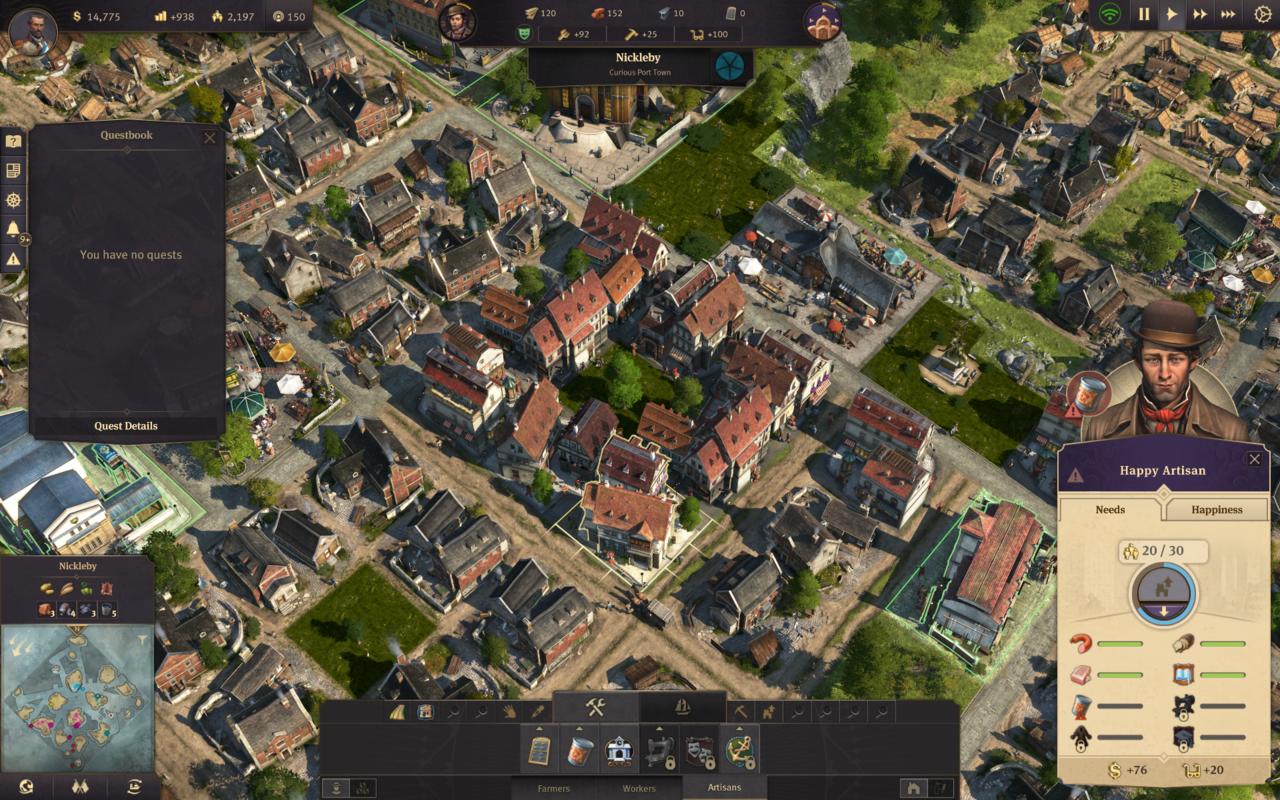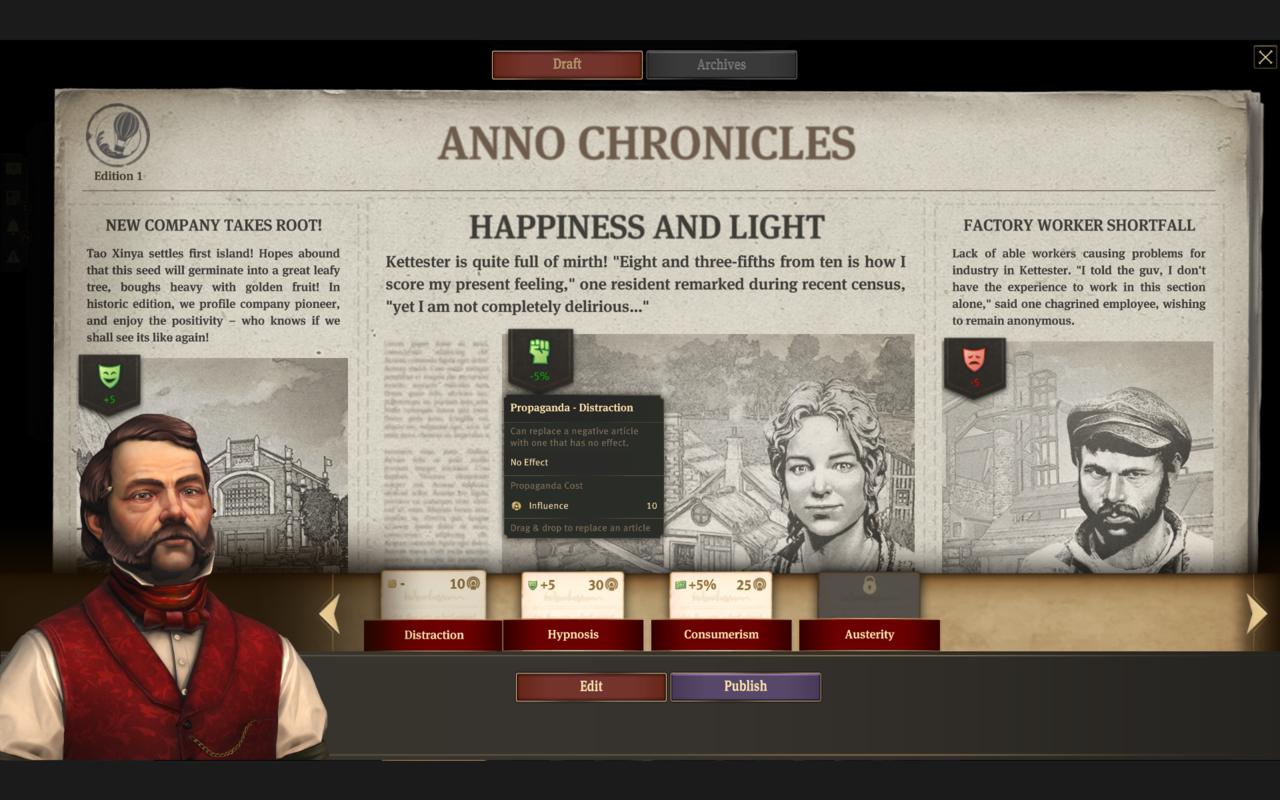At the heart of any European town founded before the 19th century lies a church. It's the same with Anno 1800. At the center of your city sits a magnificent cathedral, its spectacular steeple reaching for the heavens and illuminating the lives of everyone who passes by. It’s a very beautiful church, but it’s hiding something.
At the heart of Anno 1800 lies an intimidating and complex financial simulation. It may seem like you're overseeing the rise and occasional fall of a European-style city as it comes of industrial age. But really, you're juggling numbers, thumb wedged in the accounts ledger, finessing production efficiencies and stabilizing trade fluctuations. Anno 1800 is perhaps the prettiest spreadsheet I've ever seen.

Each randomly generated map in the core sandbox mode unfurls as a mostly blank canvas, a glistening sea dotted with fertile islands waiting to be claimed by you and your (AI or human) opponents. As you grow and expand your reach across multiple islands and into the New World--and your empire undergoes its Industrial Revolution--you'll employ more advanced technologies, extracting coal and oil to fuel great belching factories and formidable steam engines. But the basic principle remains constant: Satisfy your population by employing them to manufacture natural resources into commodities that encourage more people to move to your cities.
Everything becomes a production chain for you to configure, massage and optimize. Early on the choices you're making here are relatively simple; the virgin terrain of your first settlement makes it easy to place the knitter near the farm so the wool is delivered swiftly and the warehouse within range so the finished goods can be collected for immediate sale. But soon the need for a navy means you've had to build a sailmaker's yard which is now diverting wool previously used by the knitter. Building another sheep farm means finding the physical space for an additional farm as well as for all the extra housing for the new farmers. Extend this scenario a few hours into a game and it will encompass dozens of productions chains of increasing complexity and inter-connectivity.
Managing these productions chains--whether it's work clothes and sails or beer and pocket watches--is an enjoyable exercise in a kind of "balancing the books" sense. You know you have to spend resources to grow, but your success depends on finding that ever-moving sweet spot between overreaching and not pushing far enough. It's necessary to keep the requisite resources flowing and meet the housing and job demands of your population, but it's not sufficient. To maintain a firm hand on your economy you have to appreciate the various financial levers available to you, allowing fine adjustments to tax rates and production ratios that can genuinely mean the difference between keeping it in the black and going bankrupt.

Of course, it's also just as enjoyable to play the more visual puzzle game of city planning, slotting in that new building not only where its specific dimensions fit, but where it also retains proximity to its related structures in the chain. Nobly assisting matters here is the "move" tool that lets you--for no resource cost at all--pick up and move any building to another location. Need to pop a police station downtown but there's no room? Just move the nearby houses further down the street to open up the space. It really does look utterly beautiful when it all comes together, too, like an exquisitely detailed diorama that you can poke, prod and tweak to your heart’s content. There’s even a first-person mode that lets you walk the streets and observe all your townsfolk going about their day to day business. I especially welcomed the moments I was able to spend admiring the view before some new urgent matter warranted investigation and I had to return to crunching those numbers.
Spinning all the plates becomes even trickier as you advance into the Industrial Age. Production chains that were once straightforward, one-to-one input/output ratios turn into logistical nightmares as multiple buildings start feeding into multiple other buildings. The demands of the job are only exacerbated by a lack of clarity in the feedback you're given when things aren't operating at full capacity. Simple things like knowing how many flour mills and grain farms support a bakery just aren't communicated clearly enough in-game or in the non-existent manual. I spent hours engaged in trial and error in such situations before finding a comprehensive external wiki that I found myself alt-tabbing to constantly while I played.
There is a campaign mode that functions as a tutorial before it segues into the main sandbox. And there is an additional setting that enables a more guided experience, providing you with specific goals at the appropriate moments. I found both very welcome, even as someone who had played some of the previous Anno games. But at the same time, I felt that other important aspects weren't explained thoroughly enough, if at all, and it was frustrating to guess at solutions to problems I wasn't confident I'd even diagnosed correctly.

Much of Anno 1800 is spent watching numbers go up and down. Total gold is going down. Now it's going back up again. There aren't enough workers for the number of available jobs. Okay, now there are too many workers and not enough engineers. Sometimes it's clear why these things are happening and sometimes it's obvious what you can do to rectify the situation. However, other times it isn't and it's really quite panic-inducing. My stomach tightened whenever the numbers plummeted into the red, but as soon as they shot back into the black I would feel a surge of relief. Even so, outside of these sharp swings, when the numbers remained relatively stable and my economy seemed to be ticking over steadily, I couldn't shake this nagging sense that everything was always on the verge of complete collapse.
I spent all of my time playing Anno 1800 in a mild yet pervasive state of anxiety. As a city-building sim that emphasizes economic management, it is as robust and powerful as the steel factories it allows you to pollute the skies with. But for all the natural beauty of its island paradise and the architectural splendor of its churches, theatres, and piers, it's just a little too cold in its reliance on numbers and a little too impenetrable in its reluctance to show you its workings. I'm glad I visited, but I don't think I'd want to live there.























